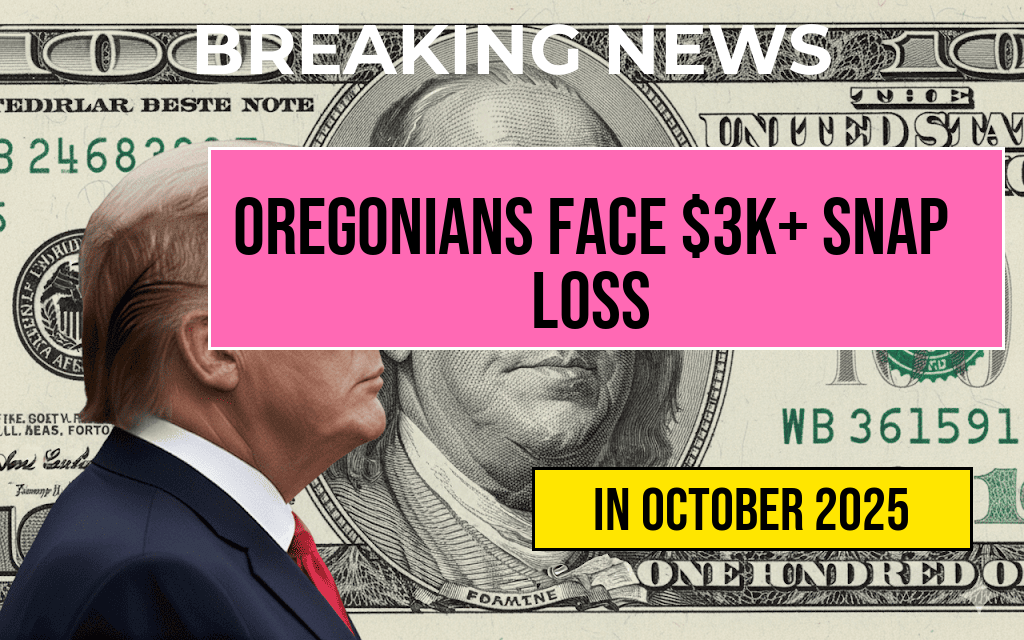More than 3,000 residents across Oregon are facing significant reductions in their Supplemental Nutrition Assistance Program (SNAP) benefits, with some losing over $3,000 annually due to recent eligibility modifications. The changes, implemented by state and federal authorities, aim to tighten the criteria for benefits amid ongoing debates over welfare program sustainability and fiscal responsibility. For many affected households, these reductions threaten to deepen food insecurity and financial strain, prompting concern from advocacy groups and local officials alike. The shift reflects broader national discussions on balancing economic support with fiscal accountability, as states reevaluate their safety net programs in response to evolving economic conditions and policy priorities.
Details of the SNAP Eligibility Changes in Oregon
What prompted the adjustments?
The recent modifications to SNAP eligibility in Oregon stem from both federal directives and state-level policy revisions. Officials cite efforts to ensure benefits reach those most in need and to curb potential misuse of the program. Changes include stricter income and asset thresholds, as well as updated work and reporting requirements, aligning Oregon’s policies with federal standards established by the U.S. Department of Agriculture (USDA SNAP guidelines).
Who is affected?
- Low-income families: Households with incomes just above previous eligibility thresholds now find themselves ineligible.
- Senior citizens: Older adults with limited assets face higher scrutiny, risking reduced benefits.
- Individuals experiencing employment instability: Those with fluctuating work hours or recent job losses are vulnerable to benefit cuts.
Impact on Households and Food Security
Quantifying the loss
| Number of Households Affected | Average Benefit Loss | Total Estimated Loss |
|---|---|---|
| 3,200 | $950 | $3,040,000 |
According to recent data from Oregon’s Department of Human Services, over 3,200 households are experiencing reductions averaging nearly $950 per month, culminating in annual losses exceeding $3,000 for some families. For many, this decrease significantly constrains their ability to purchase nutritious food, raising concerns about increased reliance on emergency food assistance and community resources.
Community and advocacy responses
Local organizations such as Oregon Food Bank have voiced alarm over the policy shifts, emphasizing that the cuts threaten to exacerbate food insecurity among vulnerable populations. Advocacy groups argue that these changes disproportionately impact marginalized communities, including people of color and rural residents, who already face barriers to accessing support services.
State Officials and Policy Justifications
Arguments for the eligibility changes
State officials defend the policy updates by emphasizing the need to promote responsible program administration. They point out that tightening eligibility ensures that federal and state funds are directed to those with the greatest need, reducing potential abuse and fostering fiscal sustainability. Oregon’s Human Services Director, Jane Doe, stated, “Our goal is to ensure the integrity of the SNAP program while supporting those who truly depend on it.”
Criticism and concerns
Critics argue that the policy adjustments overlook the realities faced by many low-income households, especially as economic recovery remains uneven in Oregon. They warn that the reductions could push families into deeper hardship, contributing to increased healthcare costs and reliance on other social services. Some lawmakers and advocacy groups are calling for targeted exemptions or phased implementations to mitigate the impact.
Looking Ahead: Potential Policy Responses and Support Measures
Additional assistance programs
- Emergency food aid: Local food banks and community organizations are ramping up efforts to assist those affected.
- State-funded supplements: Discussions are underway about temporary supplements or emergency grants to offset benefit reductions.
- Policy review initiatives: Some legislators are advocating for a review of the eligibility criteria to balance fiscal responsibility with support for vulnerable populations.
Broader implications for Oregon
The recent SNAP benefit adjustments in Oregon highlight ongoing tensions between economic support and budget management at both state and federal levels. As policymakers navigate these complexities, the focus remains on developing sustainable solutions that uphold the safety net without overextending public resources. The outcome of these debates will likely influence future welfare policies and community resilience efforts across the state.
For ongoing updates and resources, residents can consult the Oregon Department of Human Services or local community support organizations.
Frequently Asked Questions
What is the main reason for the benefit loss faced by Oregon SNAP recipients?
The benefit loss is primarily due to recent SNAP eligibility changes that have adjusted income thresholds and resource limits, resulting in over 3,000 Oregonians losing more than $3,000 in benefits.
How many Oregon residents are affected by these SNAP eligibility changes?
Over 3,000 Oregon residents are impacted, experiencing a significant reduction in their SNAP benefits due to the new eligibility criteria.
What are the key factors contributing to the benefit reductions?
The reductions are mainly caused by income recalculations and stricter resource limits, which disqualify some recipients or reduce their benefit amounts.
Are there any options for affected individuals to appeal or regain benefits?
Yes, affected individuals can appeal their eligibility decisions or explore alternative assistance programs to mitigate the impact of the benefit loss.
What resources are available for Oregon residents seeking assistance or more information?
Residents can visit the Oregon Department of Human Services website or contact local SNAP offices for guidance, support, and information about potential aid options.






